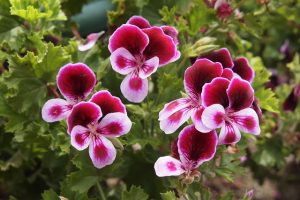In the past two months, I’ve shared with you information about Narcissus and Lilies and how they got their names. This month, I’ll be sharing information about Geraniums and Pelargoniums.
Geraniums grow wild throughout the temperate regions of the world and are commonly known as “Cranesbill” or “True Geraniums.” Geranium flowers have five petals, often with distinctive veining.
The plants most of us call “Geraniums” have the botanically proper name “Pelargoniums.” Pelargoniums also bear five-petaled flowers in umbel-like clusters – that is the flowers spread out on short stems from a central point like ribs of an umbrella. Pelargoniums are native to South Africa and have been in cultivation in Europe since the 1600s.

The confusion in the name began when Pelargoniums were originally classified as Geraniums by Carl Linnaeus, a Swedish scientist who laid the foundations for our modern scheme of binomial nomenclature in the 18th century. Perhaps you remember his method for classifying plants and animals: Kingdom, Division, Class, Order, Family, and then Genus. In 1787, Charles Louis l’Heritier divided out the South African geraniums into a separate Genus “Pelargoniums” still within the same family “Geraniaceae.” This renaming happened well over 100 years after the plant was cultivated and Geranium as the popular name stuck.
Trying not to be snobbish, some horticulturists may refer to Pelargoniums as “Pellies.” Rarely will anyone ever correct you for calling the plant a Geranium; after all, that is its family name. It would be like calling someone by their last name – not exactly wrong, but not quite right either.
Geraniums/Pelargoniums are sturdy, long-blooming plants which have been a favorite in the garden for centuries. New and continued work in breeding and cultivating keep the Geranium interesting and popular – look for new colors every year at the garden center!
Pelargonium Varieties:
The genus Pelargonium is further divided into six groups:
- Angel – named for the arrangement of petals
- Ivy – named for the shape of the leaves
- Regal – Geraniums that stand up straight
- Shrubby-leaved
- Zonal – named for the concentric markings on their leaves
- Unique – those that didn’t fit anywhere else

Angel Geranium 
Ivy Geranium 
Zonal Geranium 
Regal Geranium
Caring for your Geranium (aka Pelly)
- Pellies are heat and drought tolerant, but can handle only a minor frost.
- To deadhead, bend the main flower stem backward until it snaps from the plant stem – being careful not to break off a leg of your plant.
- Geraniums are rarely bothered by insect pests.
- A Geranium or Pelargonium grown from seed can take 5 months or more to flower so get your geraniums from the nursery.
- Pellies are sometimes grown for their scented leaves which may smell of lemon, nutmeg, apple, coconut or rose. Try rubbing the leaves and then sniffing your fingers to see if you can identify a scent.
- Pellies do not require a rest period and can be overwintered inside your home. However, they will drop most of their leaves and need to be cut back making it a messy process.
- If you’re feeling adventurous, the leaves and flowers are edible. Sprinkle over a salad for an interesting splash of color and spicy flavor.
Resources:
Crockett, James Underwood. “Pelargonium.” Annuals. New York: Time-Life, 1971. 142-43. Print.
“Geranium.” Wikipedia, the Free Encyclopedia. Web. 06 Apr. 2011. <http://en.wikipedia.org/wiki/Geranium>.
Jewell, Jennifer. “Not Your Grandmother’s Geraniums.” Colorado Homes & Lifestyles June-July 2007: 59-63. Print.
“Pelargonium.” Wikipedia, the Free Encyclopedia. Web. 06 Apr. 2011. http://en.wikipedia.org/wiki/Pelargonium.
“Seeds from Pelargonium Grossularioides / Scented Coconut Geranium.” Scented Leaf. 03 Aug. 2010. Web. 07 Apr. 2011. <http://scentedleaf.blogspot.com/2010/08/seeds-from-pelargonium-grossularioides.html>.
Wells, Diana. “Geranium.” 100 Flowers and How They Got Their Names. Chapel Hill, NC: Algonquin of Chapel Hill, 1997. 84-85. Print.



